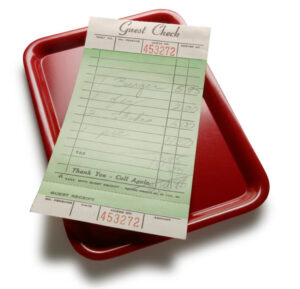 “We’re going to split the bill,” said the organizer at my friend’s birthday party. I didn’t think much of it until I ended up paying $40 for a $10 entrée. It’s hard to change how people respond to incentives. But the group dining situation is screaming for better outcomes. If you don’t like the outcomes, change the game. And the best tool is the aptly named field of mechanism design. I’ll frame the dining problem by reviewing the three common payment systems: splitting evenly, pay for what you ordered, and separate checks. I’ll then suggest a solution for those seemingly intractable birthday parties.
“We’re going to split the bill,” said the organizer at my friend’s birthday party. I didn’t think much of it until I ended up paying $40 for a $10 entrée. It’s hard to change how people respond to incentives. But the group dining situation is screaming for better outcomes. If you don’t like the outcomes, change the game. And the best tool is the aptly named field of mechanism design. I’ll frame the dining problem by reviewing the three common payment systems: splitting evenly, pay for what you ordered, and separate checks. I’ll then suggest a solution for those seemingly intractable birthday parties.
Splitting Evenly
This is probably the most common solution. But three economics professors have shown that it’s a very inefficient system.
The system is problematic because it distorts the incentives of diners. At a table of 6, each item you order contributes 1/6 to your cost and 5/6 to everyone else. You have reason to order more, and so does everyone else. The outcome is that everyone wastefully orders and everyone ends up paying too much. It’s a version of the tragedy of the commons. Restaurants are well aware that diners rack up more expenses, so that’s one reason they favor keeping a common tab.
Furthermore, splitting the bill is unfair to people who prefer less expensive items. If you’re a non-drinker, or if you’re a vegetarian, you’re probably going to end up subsidizing the meals of the meat-eating alcoholics. Or, if you are a saver, you’ll end up subsidizing the people who splurge on ridiculous items.
It’s considered impolite to point out large price differences. It makes gluttons feel guilty and ruins the mood. Besides, is there a better solution?
Yes, you might say. Just pay for what you ordered.
Pay for What You Ordered
I always say, when you collect more money than is needed, it’s a sign that you’re in good company.
Hence, pay for what you ordered is the method I use with close friends. We all trust each other to calculate tax and tip, and not screw each other over. Actually, it’s not so much that we trust each other as friends, but that we are made to trust each other in a game theory sense because we can punish cheapskates the next time we go out.
Unfortunately, this system has its flaws too. How do you split a bottle of wine? Do you go as far as calculating the cost of each glass? What about when you share food, or finish off someone’s meal because they are too full? The problem is there’s a small difference between what you order and what you eat. The system favors people who order cheaper items but then try to sample as much as possible of other people’s food.
There’s one more issue. It’s often not possible to say who put in what. There’s an incentive to pay just a little bit less hoping someone else will be generous and cover. If the pot is short, often everyone is asked to put in an extra dollar or two. So the system still favors the cheapskates—especially the people who pay less and then sneak away to the bathroom when everyone is asked to pitch in more.
If you don’t trust your company, why not just separate checks?
Separate Checks
This is the most efficient system, in terms of incentives. People will only order what they really want because they ultimately have to pay for it. Perhaps this is why researchers found that 80% of subjects favored separate checks.
So the economics are pretty favorable, but there are a few practical problems.
First, it takes longer to pay as your party size gets bigger. As a matter of practice, waiters don’t enjoy this.
Second, separate checks are impractical when you’re sharing appetizers or bottles of wine. What if you share an appetizer with one friend but then take a glass of wine that was split with four other people? It’s a hassle to sort it all out.
Third, in parties, people usually treat the guest of honor. Would a restaurant actually split one item across everyone else’s bill? I am not sure, as I’ve ever seen this.
Perhaps the biggest problem is that separate checks are not even allowed at some restaurants—particularly nicer ones. It’s probably because they know people order more on a common bill, and it’s somehow seen as less “classy” to offer separate checks. I don’t totally understand it, but I have been rejected by at least one snobby waiter (Oh, no, no, monsieur, we don’t do that).
Thinking about an ideal outcome
What’s an ideal outcome? I think it would have three elements: that each person orders properly, each person pays what is owed, and the money is collected quickly.
How do the three methods compare on these criteria?
Splitting the bill –>Over order, over pay, quick collection
Pay what you ordered–>Order correctly, a few overpay, moderately fast collection
Separate checks–>Inconvenient for sharing, pay correctly, slow collection
So each method is the best at exactly one trait. Perhaps that’s why there’s such disagreement over what to do—each method has its unique merit.
Let’s abstract the problem a little more to consider why the dining problem is so complicated. I see six main characteristics that cause trouble:
1. Hidden preferences on food
2. Hidden willingness to pay
3. Selfish desire to pay less
4. Desire to look fair
5. Desire to maintain party atmosphere
6. Hidden payments on a common bill
I’ve mulled over several solutions, and I think I’ve come up with a good start.
I’ll deal with the situation of a birthday party with a large number of people. Other situations can be handled similarly—they might even be easier because you don’t have to cover the guest of honor’s meal.
The Suggested Answer
Such a simple situation demands an answer! But how might we proceed? There are two big steps that can make a drastic difference.
The first step has to do with the problem of disparity. Often, people end up ordering items that cost vastly different amounts. While it’s nice to have choice, it’s worse that everyone ends up with a wildly different amount that’s owed. This confusion is what allows cheaters to conceal their motives and pay less.
Thus, the first step is to make everyone happier by offering a reasonable menu. The most practical way is to call the restaurant and see if you can make a special fixed menu. Some restaurants will print you small menu cards to make the occasion special. But don’t worry if they don’t–just make your own menu. Select a few reasonably priced items and design your own menu to hand out to guests.
The second step is to assign one person as the money collector. Preferably this takes place before any one eats food. This guarantees guests have money, and creates an incentive for someone to collect fairly. In large parties, you could even offer to compensate this person a few bucks from the group. I am sure everyone would be willing to willing to spend an extra dollar to ensure the party atmosphere is good. If your party does not have an organizer, volunteer! People will be happy.
Here’s how the solution might work in practice.
An example calculation
Let’s say you have 10 guests, plus one birthday boy. You want to go to Gordon Biersch, a brewery restaurant.
They have lots of food on the menu. I count 13 starters, 12 salads, 10+ pizzas, 5 steaks, 6 seafood dishes, 5 specialties, 9 pastas, 14 sandwiches, and 5 desserts.
There is a large difference between a $10 burger and a $27 steak, so you can already see that a free-for-all “split-the-meal” is going to be a disaster. And I didn’t even mention the drink menu.
Here’s one way to proceed.
Step One: Create a reasonable fixed menu
Choose 3 garlic fries starters for everyone to share.
For drinks, allow people to order a soda or beer. Avoid complications like sharing wine.
Limit the menu to pizzas (except do it yourself) and sandwiches. The price range is $9-$12.25.
Choose 5 desserts for the table to share.
Step Two: Estimate costs and collect the money in advance
I will round some costs up to be safe.
3 garlic fries 3 x $6 = $18.00
11 entrees 11 x $12.50 = $137.50
5 desserts 5 x $6.25 = $31.25
2 beers for birthday boy 2 x $5 = $10.00
Total common = $196.75
Tax + Tip (8% +18%) = $247.91
Per 10 people (treat the birthday boy) = $24.79–>round to $25
The only difference in what people pay is the choice of drinks. I think sodas cost $2 and beers $5. I’ll add tax and tip and do some rounding.
Soda: Contribute $28
1 beer: Contribute $31.50
2 beers: Contribute $38
n beers: Contribute $25 + $6.50 n
That’s it! Collect money in advance, and you’ll have every thing covered.
Step Three: Send everyone an email
The dining problem is about expectations and information. Get every one on the same page before the party starts. Here’s an email you could send to all your attendees:
Hi everybody,
We’re going to be celebrating Dan’s birthday party next Friday at Gordon Biersch.
Because we have a large group, I want to coordinate the food and cost in advance so the party runs smoothly.
For the entrée, we request you order a pizza (except “make your own”) or a sandwich.
For the appetizers and desserts, I will order a few for the whole table to share.
As for paying, we’re going to split the costs (and pay for Dan’s meal). This should be fair because the pizza and sandwich entrees are similarly priced. It’s not perfect, but it will make collection easy.
I’ve estimated the costs and have a very good idea of what you’ll need to pay. The only difference is what you decide to drink. Here are the estimated costs:
No drink: Contribute $25
Soda: Contribute $28
1 Beer: Contribute $31.50
2 Beers: Contribute $38
n Beers: Contribute $25 + $6.50 n
Please pay me in cash before you start eating. In the unlikely event we’re short, I will ask everyone to chip in an extra dollar or two. Please don’t run to the bathroom when it comes time to pay the bill.
Let me know if you have any questions…
Under this solution, people will roughly pay for what they order, it’s easy to collect and enforce payment, and a good time should be had by all. No one will be surprised by the $25 minimum cost. Big spenders can order more beers for themselves.
Some of you might be thinking, “What, no wine? No steak?” I agree the choice is limited. But I think people are willing to give up a little choice in exchange for everyone having a good party. This is because parties are not about getting exactly what you want–you can do that on your own time. It’s about coordinating a large group.
Do you have another solution to the dining problem? Please share in the comments and I’ll post the best ideas.
 The concept “egonomics” was introduced by Schelling in 1978, in his address to the American Economic Association. He was musing, in particular, on the ways in which people manage themselves either to do, or to avoid doing, particular activities or behaviors – the “tricks” they play on themselves in order to make unpleasant or difficult decisions unnecessary. Some of the examples he gave were to place the alarm clock at the other side of the room so it cannot be turned off without getting out of bed; to deliberately set watches a few minutes ahead of time to avoid being constantly late; to be committed to weekly payments into a Christmas Club to make saving easier and savings less readily accessible during the rest of the year and, at the extreme, to dieters having their jaws wired up in order to avoid the temptation of food. Putting things out of reach, or the self-promise of a small reward, or surrendering authority to a trustworthy friend, were all, Schelling suggested, means of policing or managing the self. Using cigarette smoking as an example, he went on to posit that addictive behaviors demonstrated an anomaly in consumer theory in that “consumers are getting negative satisfaction out of something they spend a lot of money to consume”. In other words, despite the known detrimental social, health and financial consequences, people continue to be hooked into the behavior. The way some of them can reverse the addiction is through, amongst other tactics, paying for support of professionals, drugs or behavior-aversive aids. The suggestion is that with both “positive” behaviors (regular saving, exercising, meeting deadlines) and “negative” behaviors such as cigarette smoking, the consumer will find ways of managing the self, whether through self-reward or self-intimidation.
The concept “egonomics” was introduced by Schelling in 1978, in his address to the American Economic Association. He was musing, in particular, on the ways in which people manage themselves either to do, or to avoid doing, particular activities or behaviors – the “tricks” they play on themselves in order to make unpleasant or difficult decisions unnecessary. Some of the examples he gave were to place the alarm clock at the other side of the room so it cannot be turned off without getting out of bed; to deliberately set watches a few minutes ahead of time to avoid being constantly late; to be committed to weekly payments into a Christmas Club to make saving easier and savings less readily accessible during the rest of the year and, at the extreme, to dieters having their jaws wired up in order to avoid the temptation of food. Putting things out of reach, or the self-promise of a small reward, or surrendering authority to a trustworthy friend, were all, Schelling suggested, means of policing or managing the self. Using cigarette smoking as an example, he went on to posit that addictive behaviors demonstrated an anomaly in consumer theory in that “consumers are getting negative satisfaction out of something they spend a lot of money to consume”. In other words, despite the known detrimental social, health and financial consequences, people continue to be hooked into the behavior. The way some of them can reverse the addiction is through, amongst other tactics, paying for support of professionals, drugs or behavior-aversive aids. The suggestion is that with both “positive” behaviors (regular saving, exercising, meeting deadlines) and “negative” behaviors such as cigarette smoking, the consumer will find ways of managing the self, whether through self-reward or self-intimidation.




